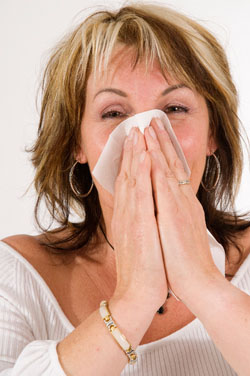By Al Sears, MD

Seasonal allergies have finally met their match
Do you know how hay fever got its name? In England, they harvest alfalfa and other grasses to make hay for winter animal feed. It’s the “dust” from these grasses that are the original cause of hay fever.
A British doctor named John Bostock originally described the symptoms way back in 1819. He called it “a periodical infection of the eyes and chest.”1
Today, we know that what happens is an overreaction of your immune system to particles in the air, like pollen and ragweed. They are produced by trees in the spring, and grasses in the early summer.
Scientists have a fancier name for hay fever. They call it seasonal allergic rhinitis. But the symptoms are the same. You might get a runny nose, a cough and a sore throat. And you may also sneeze a lot and have reddened, itchy, watery eyes.
Some fairly common natural remedies for allergies are nettle, capsaicin and quercetin. These are all great for clearing out airways and relieving sinus congestion. But they don’t get to the root of the problem and make you less sensitive to the particles that can irritate you in the first place.
Instead, here are three ways to help stop the suffering before it starts, and keep hay fever away this year, and every year.
1) Vitamin D — People with low levels of vitamin D seem to be more likely to have breathing problems and allergies.
– The National Health and Nutrition Examination Survey found that allergies were much more common in children with low levels of vitamin D. For example, they were almost five times more likely to be allergic to oak pollen.2
– Another study found that those with low vitamin D produced more of the IgE molecule that increases allergic response.3
Vitamin D is essential to normal immune response. The first thing immune cells do before they can fight attackers is look for vitamin D. If your vitamin D level isn’t normal, your immune function won’t be normal, either.
You should be able to get more than enough vitamin D by going outside in the sunshine every day for about 20 minutes. If you can’t get out in the sun, there are a few foods you can eat that have lots of vitamin D, including eggs, mushrooms, alfalfa and small fish like herring. Another is cod liver oil. One teaspoon contains 1,360 IU of vitamin D. If you need to supplement, I recommend at least 2,000 IU each day.
2) Butterbur — This shrub grows mostly in damp, marshy spots throughout Europe. It’s been used for centuries to treat headaches and respiratory illnesses. It’s now considered excellent for allergy prevention.
In one study, they gave people suffering from hay fever either butterbur, or a dose of the prescription drug cetirizine. You might know it better as Zyrtec. The people taking butterbur got the same relief from pain and other symptoms.4
And butterbur didn’t make anyone drowsy or “foggy,” so those people were able to do more and feel more vital than people taking the drug.
Butterbur has petasines, which help block IgE from causing allergic reactions. It also helps calm smooth muscle spasms to relieve sneezing. I recommend taking 100 mg twice a day for a week or so before allergy season starts, then drop back to 50 mg a day.
3) Beeswax Candles — For hundreds of years, candles were made from beeswax, not petroleum (paraffin) like they are today.
And beeswax candles filter the air you breathe.
That’s because burning beeswax is the only fuel that emits negatively charged ions. Negative ions are what many electronic air purifiers use, and what doctors use to treat babies with bronchitis and asthma.
The negative ions connect with positively charged ions that carry dust, mold, bacteria, viruses and other allergens. The excess weight causes the irritants in the air to fall to the ground where they can be swept up or vacuumed.
To get the anti-allergy benefits, burn a 100% beeswax candle in your room for a few hours before bedtime. But make sure you get the real thing. Many candles labeled “beeswax” are a combination of beeswax and paraffin. When in doubt, your nose will tell you every time. Beeswax has a uniquely fresh smell, which is distinctly different from paraffin.
Plus, you get a beeswax bonus: When your candle has reached its end, use the leftovers to make a natural lip balm or hand cream.
Most Popular:
 8 Homeopathic Pain Relievers for
8 Homeopathic Pain Relievers for
Just 10 Cents
References
1 Bostock, John, “Case of a Periodical Affection of the Eyes and Chest,” Med. Chir. Trans. 1819;10(Pt 1):161—165
2 Sharief, Shimi, MD, et al, “Vitamin D levels and food and environmental allergies in the United States: Results from the National Health and Nutrition Examination Survey 2005-2006,” Journal of Allergy and Clinical Immunology Feb 2011
3 Brehm, John M., et al, “Serum Vitamin D Levels and Markers of Severity of Childhood Asthma in Costa Rica,” Am. J. Respir. Crit. Care Med. May 1, 2009;179(9):765—771
4 Schapowal, Andreas, “Randomised controlled trial of butterbur and cetirizine for treating seasonal allergic rhinitis,” BMJ January 2002;324

